Heater Water Pump (W/ Viscous Heater) -- Installation |
| 1. INSTALL IDLER PULLEY BRACKET (w/ Belt Tension Side) |
 |
Install the bracket with the 3 bolts.
- Torque:
- 48.5 N*m{495 kgf*cm, 36 ft.*lbf}
| 2. INSTALL IDLER PULLEY BRACKET |
 |
Install the bracket with the bolt.
- Torque:
- 48.5 N*m{495 kgf*cm, 36 ft.*lbf}
| 3. INSTALL VISCOUS WITH MAGNET CLUTCH HEATER ASSEMBLY |
 |
Install the heater assembly with the 2 bolts.
- Torque:
- 48.5 N*m{495 kgf*cm, 36 ft.*lbf}
Connect the 2 heater hoses.
Using pliers, grip the claws of the clips and slide the 2 clips.
Connect the connector and attach the clamp.
| 4. INSTALL IDLER PULLEY ASSEMBLY |
 |
Install the 2 idler pulleys with the 2 bolts.
- Torque:
- 48.5 N*m{495 kgf*cm, 36 ft.*lbf}
| 5. INSTALL RADIATOR ASSEMBLY |
Install the radiator assembly (Click here).
| 6. INSTALL RADIATOR RESERVE TANK ASSEMBLY |
Install the radiator reservoir with the 3 bolts.
 |
Connect the 2 hoses to the upper radiator tank and water inlet.
- HINT:
- Make sure the directions of the hose clamps are as shown in the illustration.
| 7. INSTALL FAN SHROUD WITH FAN |
Install the shroud together with the fluid coupling fan between the radiator and engine components.
- NOTICE:
- Be careful not to damage the radiator core.
Temporarily install the fluid coupling fan to the fan bracket with the 4 nuts.
- HINT:
- Tighten the nuts as much as possible by hand.
 |
Attach the shroud claws to the radiator.
 |
Install the shroud with the 2 bolts.
- Torque:
- 8.0 N*m{82 kgf*cm, 71 in.*lbf}
Tighten the 4 nuts of the fluid coupling fan.
- Torque:
- 21 N*m{214 kgf*cm, 15 ft.*lbf}
 |
| 8. INSTALL OIL COOLER HOSE (w/ Air Cooled Transmission Oil Cooler) |
Temporarily install the oil cooler tube to the fan shroud with the bolt labeled A. Install the bolt labeled B. Then tighten the bolt labeled A to the specified torque.
- Torque:
- 5.0 N*m{51 kgf*cm, 44 in.*lbf}
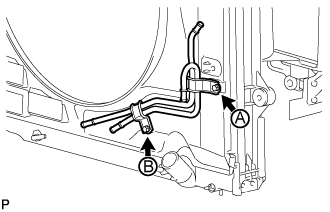 |
Connect the inlet No. 4 oil cooler hose as shown in the illustration.
Text in Illustration *1 Paint Mark - NOTICE:
- Make sure the pinching portion of each clip is facing the direction shown in the illustration.
 |
Connect the inlet No. 2 and No. 3 oil cooler hoses as shown in the illustration.
- NOTICE:
- Make sure the pinching portion of each clip is facing the direction shown in the illustration.
 |
Connect the inlet and outlet No. 1 oil cooler hoses as shown in the illustration.
Text in Illustration *1 Paint Mark - NOTICE:
- Make sure the pinching portion of each clip is facing the direction shown in the illustration.
 |
Pass the hose through the flexible hose clamp and close the clamp shown in the illustration.
| 9. INSTALL NO. 2 RADIATOR HOSE |
| 10. INSTALL NO. 1 RADIATOR HOSE |
| 11. INSTALL VANE PUMP ASSEMBLY |
Apply a light coat of engine oil to a new O-ring, and install it to the vane pump.
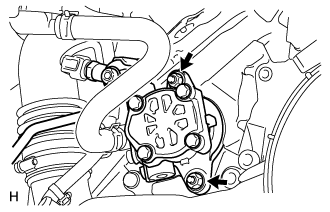 |
Install the vane pump with 2 new nuts.
- Torque:
- 29 N*m{296 kgf*cm, 21 ft.*lbf}
| 12. INSTALL VANE PUMP OIL RESERVOIR ASSEMBLY |
Install the vane pump oil reservoir to the bracket.
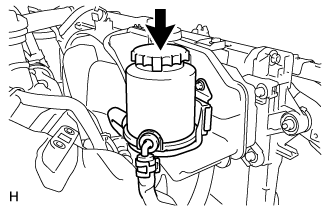 |
| 13. INSTALL V-RIBBED BELT |
Install the V-ribbed belt as shown in the illustration.
 |
Temporarily install the lock nut, and turn the bolt clockwise.
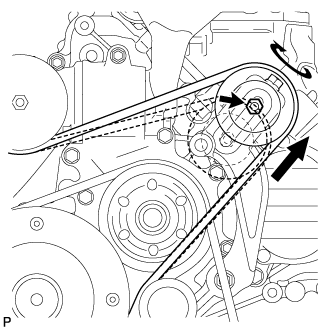 |
Using a belt tension gauge, inspect the belt tension.
- Standard Belt Tension:
Item Condition Specified Condition New belt 5 to 35°C (41 to 95°F) 550 to 800 N (56 to 82 kgf, 123.6 to 179.8 lbf) Used belt 5 to 35°C (41 to 95°F) 300 to 500 N (31 to 51 kgf, 67.4 to 112.4 lbf)
Text in Illustration *a Measuring Point - HINT:
- When measuring the tension of a new belt, measure the tension immediately after installing it to the engine but before starting the engine.
- A "new belt" is a belt which has been used for less than 5 minutes on a running engine.
- A "used belt" is a belt which has been used on a running engine for 5 minutes or more.
- After installing a new belt, run the engine for approximately 5 minutes and then recheck the tension.
 |
Tighten the nut.
- Torque:
- 40 N*m{408 kgf*cm, 30 ft.*lbf}
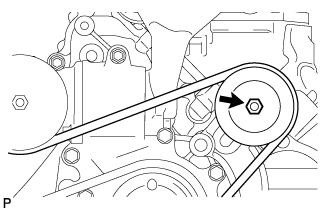 |
Check that the belt fits properly in the ribbed grooves.
- HINT:
- Check with your hand to confirm that the belt has not slipped out of the groove on the bottom of the pulley.
- If it has slipped out, replace the V-ribbed belt. Install a new V-ribbed belt.
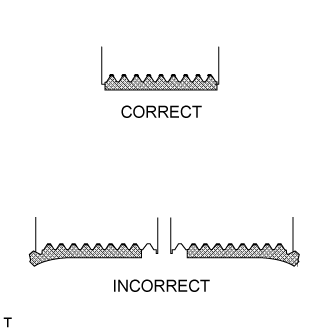 |
| 14. INSTALL INTAKE AIR CONNECTOR |
Connect the intake air connector to the No. 1 and No. 2 air cleaner pipes.
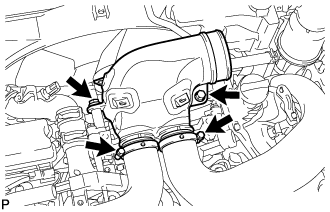 |
Install the connector with the 2 bolts.
- Torque:
- 21 N*m{214 kgf*cm, 15 ft.*lbf}
Tighten the 2 hose clamps.
- Torque:
- 6.3 N*m{64 kgf*cm, 56 in.*lbf}
Attach the 3 wire harness clamps.
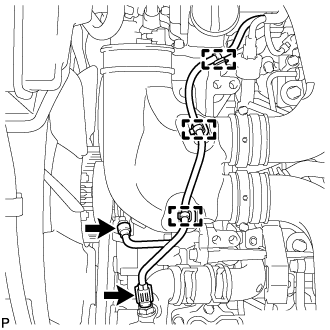 |
Connect the 2 connectors to the water temperature sensor and viscous heater.
| 15. TEMPORARILY INSTALL NO. 1 AIR CLEANER HOSE |
Temporarily install the air cleaner hose to the intake air connector.
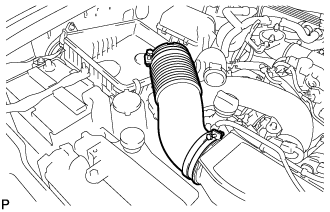 |
| 16. INSTALL AIR CLEANER CAP SUB-ASSEMBLY |
Align the protrusion of the air cleaner cap and concave portion of the air cleaner hose.
 |
Connect the air cleaner cap to the air cleaner hose, and install the air cleaner cap with the 3 clamps.
 |
Tighten the 2 hose clamps and connect the connector.
- Torque:
- 2.5 N*m{25 kgf*cm, 22 in.*lbf}
| 17. INSTALL NO. 1 ENGINE COVER SUB-ASSEMBLY |
Install the engine cover with the 2 nuts.
- Torque:
- 8.0 N*m{82 kgf*cm, 71 in.*lbf}
 |
| 18. INSTALL NO. 3 ENGINE ROOM WIRE |
Install the No. 3 engine room wire to the main battery and sub-battery positive terminals with the 2 nuts.
- Torque:
- 7.6 N*m{77 kgf*cm, 67 in.*lbf}
Connect the No. 3 engine room wire with the 4 clamps.

| 19. INSTALL UPPER RADIATOR SUPPORT SEAL |
Install the radiator support seal with the 7 clips.
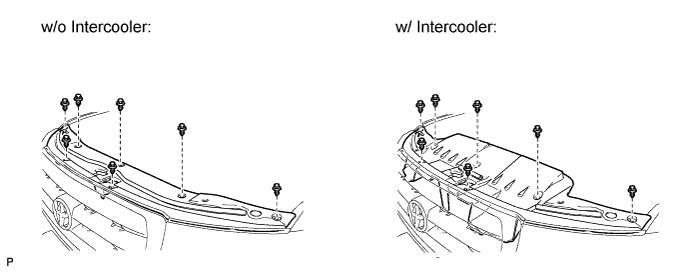
| 20. ADD ENGINE COOLANT |
Remove the engine air bleed cap.
 |
Connect a clear hose to the engine air bleed pipe.
 |
Using a wrench, remove the vent plug.
 |
Fill the radiator with TOYOTA SLLC to the radiator reservoir filler neck.
- HINT:
- Pour TOYOTA SLLC until it spills out of the engine air bleed pipe.
- Standard Capacity (for Automatic Transmission):
Item Specified Condition Front heater only 14.8 liters (15.6 US qts, 13.0 Imp. qts) Front heater and rear heater 17.6 liters (18.6 US qts, 15.5 Imp. qts) Front heater with viscous heater 15.2 liters (16.1 US qts, 13.4 Imp. qts) Front heater and rear heater with viscous heater 18.0 liters (19.0 US qts, 15.4 Imp. qts)
- Standard capacity (for Manual Transmission):
- 15.4 liters (16.3 US qts, 13.5 Imp. qts)
- NOTICE:
- Do not substitute plain water for engine coolant.
- HINT:
- TOYOTA vehicles are filled with TOYOTA SLLC at the factory. In order to avoid damage to the engine cooling system and other technical problems, only use TOYOTA SLLC or similar high quality ethylene glycol based non-silicate, non-amine, non-nitrite, non-borate coolant with long-life hybrid organic acid technology (coolant with long-life hybrid organic acid technology consists of a combination of low phosphates and organic acids).
 |
Install the vent plug.
- Torque:
- 2.0 N*m{20 kgf*cm, 18 in.*lbf}
- NOTICE:
- Do not tighten the plug to 5.0 N*m (51 kgf*cm, 44 in.*lbf) or more, as the plug will be damaged.
 |
Disconnect the clear hose from the engine air bleed pipe.
 |
Install the engine air bleed cap when coolant comes out.
 |
Install the radiator reservoir cap.
Start the engine.
- NOTICE:
- Immediately after starting the engine, if the radiator reservoir does not have any coolant, perform the following: 1) stop the engine, 2) wait until the coolant has cooled down, and 3) add coolant until the coolant is filled to the FULL line.
Maintain an engine speed of 3000 rpm for approximately 10 minutes so that the thermostat opens and air bleeding is performed.
- CAUTION:
When pressing the radiator hoses:- Wear protective gloves.
- Be careful as the radiator hoses are hot.
- Keep your hands away from the radiator fan
- NOTICE:
- Pay attention to the needle of the water temperature meter. Make sure that the needle does not show an abnormally high temperature.
- If there is not enough coolant, the engine may burn out or overheat.
- HINT:
- The thermostat opening timing can be confirmed by pressing the No. 2 radiator hose by hand, and checking when the engine coolant starts to flow inside the hose.
Stop the engine, and wait until the engine coolant cools down to ambient temperature.
- CAUTION:
- Do not remove the radiator reservoir cap while the engine and radiator are still hot. Pressurized, hot engine coolant and steam may be released and cause serious burns.
Check that the coolant level is between the FULL and LOW lines.
If the coolant level is above the FULL line, drain coolant so that the coolant level is between the FULL and LOW lines.
 |
| 21. INSTALL NO. 1 ENGINE UNDER COVER SUB-ASSEMBLY |
Install the No. 1 engine under cover with the 10 bolts.
- Torque:
- 29 N*m{296 kgf*cm, 21 ft.*lbf}
| 22. INSTALL FRONT FENDER SPLASH SHIELD SUB-ASSEMBLY LH |
for Standard:
Install the front fender splash shield (Click here).
w/ Winch:
Install the front fender splash shield (Click here).
| 23. INSTALL FRONT FENDER SPLASH SHIELD SUB-ASSEMBLY RH |
for Standard:
Install the front fender splash shield (Click here).
w/ Winch:
Install the front fender splash shield (Click here).
| 24. CONNECT CABLE TO NEGATIVE BATTERY TERMINAL |
- NOTICE:
- When disconnecting the cable, some systems need to be initialized after the cable is reconnected (Click here).
| 25. CHECK FOR ENGINE COOLANT LEAKS |
- CAUTION:
- Do not remove the radiator reservoir cap while the engine and radiator are still hot. Pressurized, hot engine coolant and steam may be released and cause serious burns.
Fill the radiator with coolant and attach a radiator cap tester to the radiator reservoir.
 |
Warm up the engine.
Using the radiator cap tester, increase the pressure inside the radiator to 123 kPa (1.3 kgf/cm2, 17.8 psi), and check that the pressure does not drop.
If the pressure drops, check the hoses, radiator and water pump for leaks.
If no external leaks are found, check the cylinder block and cylinder head.